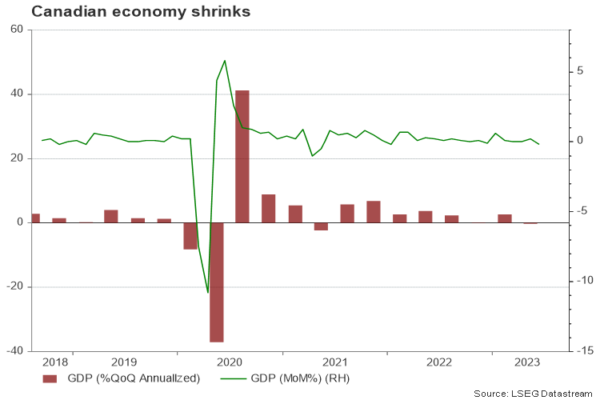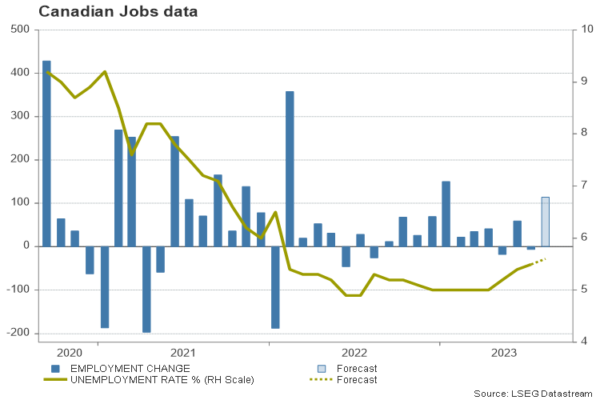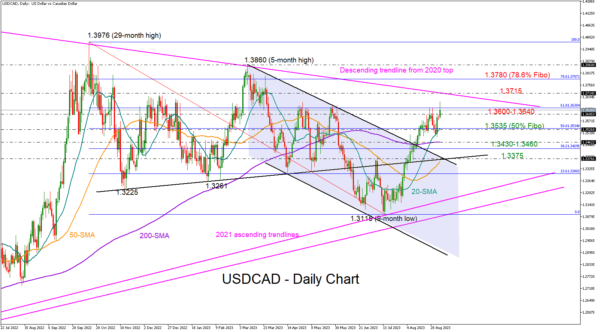The Bank of Canada (BoC) might move to the sidelines on Wednesday at 14:00 GMT after two rate increases during the summer. Investors are not seeing any additional hikes in the year ahead, but they have not excluded the case entirely. Hence, any clues the central bank could return to the tightening path in the foreseeable future could provide some footing to the loonie. Yet, with the economy fizzling out, the central bank may refrain from boosting rate expectations, likely providing poor support to the Canadian currency.
Will the BoC pause rate hikes?
The Canadian dollar has been a victim of the greenback, depreciating by more than 4.0% since July’s BoC policy meeting helped it bounce to a nine-month high. The loonie has completely reversed its May-July upleg, and despite the recent resurgence in crude oil prices, it could barely find its feet, with traders currently wondering whether September’s policy meeting on Wednesday could stop the melting.
The short answer is no. Investors are certain that the central bank will leave interest rates unchanged at 5.0% and perhaps it may not have a good reason to justify additional rate increases this time.
During its previous gathering, the central bank saw inflation returning sustainably to its 2.0% midpoint target by the middle of 2025. Therefore, since policymakers are not scheduled to update their economic projections before October, it would be unwise to suddenly shut the door to additional tightening. Unlike its US peer, the BoC has a flexible inflation target set within a control band of 1-3%, and the CPI measures are currently slightly above that range. This could lead to less commitment to future rate increases, especially since the Q2 GDP data arrived surprisingly lower than expected.
Canadian economy shrinks
The Canadian economy contracted by 0.2% on an annualized basis in Q2, while a preliminary GDP estimate for July and the latest gloomy Ivey business PMI survey sent negative warnings for the third quarter too. Recall that the central bank hoped for a stronger annualized growth of 1.5% y/y back in July.
Probably the wildfires in the country caused limited access to resources and disturbed business activities. But the decline in housing investment and the slowdown in consumption could also be a broader sign that the economy is starting to feel the pain from higher borrowing costs.
The soft rebound in the unemployment rate might further motivate a pause this month and allow some time for monitoring. August’s jobs report will be published two days after the rate announcement on Friday at 12:30 GMT, with forecasts pointing to a higher employment growth of 15k compared to the 6.4k decline registered in July. Interestingly, the unemployment rate is expected to rise for the third consecutive month to 5.6%.
Market reaction
For now, the central bank could switch to a neutral stance, avoiding any hawkish signals, and, more importantly, any language that could bolster rate cut speculation. If this scenario plays out, the loonie may find it hard to change course to the upside, unless the Canadian Jobs numbers show a significant improvement and US headlines add pressure to the greenback.
From a technical perspective, a rebound in the loonie cannot be ruled out. Dollar/loonie is currently struggling to overcome the familiar resistance of 1.3640, while the descending trendline from the 2020 top could be another headache at 1.3730.
On the downside, the 20-day simple moving average (SMA) could ease downside forces around 1.3535 ahead of the 200-day SMA at 1.3460 and the 1.3430 support region.















